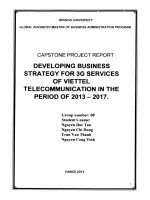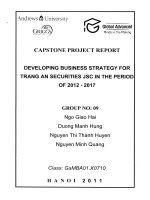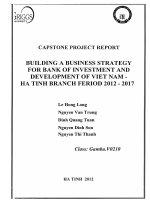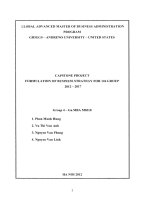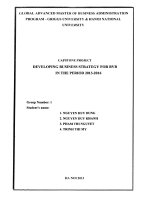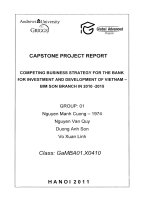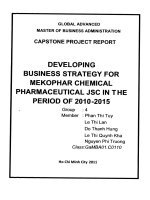Development business strategy for period of 2013 - 2018 of Hanoi food import - exportjoint stock company (Vihafoodco)
Bạn đang xem bản rút gọn của tài liệu. Xem và tải ngay bản đầy đủ của tài liệu tại đây (3.14 MB, 94 trang )
Strategic Management
Global Advanced Master of Business Administration
CAPSTONE PROJECT REPORT
STRATEGIC MANAGEMENT
DEVELOPMENT BUSINESS STRATEGY
FOR PERIOD OF 2013 – 2018 OF
HANOI FOOD IMPORT – EXPORT
JOINT STOCK COMPANY
(VIHAFOODCO)
Class: GaMBA01.C0111
Group 3:
Nguyen Huu Ba
Nguyen Van Chien
Le Thi Thanh Hai
Nghiem Quoc Phu
Ngo Xuan Phuc
Ho Chi Minh City, January 2013
Strategic Management
- 2-
CONTENTS
CONTENTS 2
Table of figures: 5
Table of table: 6
LETTER OF THANKS 8
INTRODUCTION 9
1. Reasons for choosing topic: 9
2. Study objectives: 9
3. Objects and scope of the research. 10
4. Research Methodology: 10
5. Scientific and practical significance of the research topic: 10
6. The structure of the topic: 11
CHAPTER 1. THEORETICAL BASIS OF STRATEGY ANDSTRATEGIC PLANNING 12
1.1. The concept of strategy and business strategy 12
1.1.1. The concept 12
1.1.2. The role of strategic management 12
1.2. The steps for strategy planning 13
1.2.1. Environmental study 13
1.2.1.1. External environment 13
1.2.1.2. Internal environment of business: 18
1.2.2. Determine the goals of the business. 19
1.2.3. Develop strategy, choose key strategy. 19
1.3. Supporting tools for identifying, selecting strategies 19
1.3.1. The external factors evaluation matrix tool - EFE 19
1.3.2. The internal factors evaluation matrix tool – IFE 20
1.3.3. CPM - Company Profile Matrix tool 21
1.3.4. SWOT matrix tool 22
1.3.5. QSPM Matrix Tool 24
CHAPTER 2. OPERATING ENVIRONMENT OF VIHAFOODCO COMPANY 25
Strategic Management
- 3-
2.1. Overview on the VIHAFOODCO: 25
2.1.1. Establishment legality: 25
2.1.2. The process of formation and development: 26
2.1.3. Organizational structure: 27
2.1.4. Production capacity: 28
2.2. Analysis of the external environment (EFE), identify opportunities and risks affecting the
business activities of the company: 30
2.2.1. Macro environment: 30
2.2.1.1. Political environment, policy and law: 30
2.2.1.2. Population, social and cultural environment 30
2.2.1.3. Technology environment: 31
2.2.1.4. Economic environment: 31
2.2.2. Micro Environment: 34
2.2.2.1. The world market: 34
2.2.2.2. Vietnam's rice export market: 39
2.2.2.3. Evaluation of Competitors’ competitiveness in the supply of rice for
export by CPM 41
2.2.3. Identify opportunities and risks affecting the business activities of the company: 44
2.2.3.1. Opportunities: 44
2.2.3.2. Risks: 44
2.2.3.3. Matrix evaluates external factors: 44
2.3. Internal environment analysis of the company: 46
2.3.1. Analysis of business activity: 46
2.3.1.1. Management: 46
2.3.1.2. Marketing: 49
2.3.1.3. Producing operations and export supply: 54
2.3.1.4. Information system: 58
2.3.1.5. Human Resources: 59
2.3.1.6. The financial situation of the company: 60
Strategic Management
- 4-
2.3.2. Identify the strengths, weaknesses, and internal elements -IFE Matrix: 65
2.3.2.1. Strengths: 66
2.3.2.2. Weaknesses: 66
2.3.2.3. Internal Factor Evaluation Matrix (matrix - IFE): 67
2.4. Construct value chain for VIHAFOODCO: 69
2.4.1. Overview of export rice value chain: 69
2.4.2. Value Chain of VIHAFOODCO - export suppliers: 70
CHAPTER 3. CONSTRUCTION OF BUSINESS STRATEGYFOR THE PERIOD OF 2013 - 2018 OF
VIHAFOODCO 72
3.1. Identify the vision and mission of VIHAFOODCO: 72
3.1.1. Vision 72
3.1.2. Mission: 72
3.1.3. Core value: 72
3.2. Identify the objectives: 73
3.3. Construction of business strategy for the period 2013-2018 of VIHAFOODCO: 73
3.3.1. General objectives: 73
3.3.2. Specific objectives: 73
3.3.3 SWOT matrix of VIHAFOODCO: 76
3.3.4 Selection Strategy by QSPM: 78
3.3.5 Solutions to implement the business strategy of VIHAFOODCO for the period 2013
– 2018 79
3.3.5.1 Market Development Strategy: 79
3.3.5.2 Branding Strategy: 82
3.4 Recommendations: 85
3.4.1 For the Government: 85
3.4.2 Recommendations for companies in the industry (VFA) 86
CONCLUSION 88
APPENDIX 89
REFERENCES 94
Strategic Management
- 5-
Table of figures:
Figure 1-1: Total strategic management Model of Fred R. David 13
Figure 1-2: Model of five competitive forces of Michael E.Porter 15
Figure 2-1: The structure of organization, management and operation of the
VIHAFOODCO 28
Figure 2-2: The process of rice processing in the factory 29
Figure 2-3: Global rice production from 2000 - 2012 * (million tons) 35
Figure 2-4: Rice consumption volume and reserve/consumption rate in the world
throughout the years 36
Figure 2-5: Turnover and export production in the first nine months of 2012 and
compared with the same period of the previous year 39
Figure 2-6: Density of exported rice in recent years 40
Figure 2-7: Export market of Vietnamese rice 41
Figure 2-8: Export supply situation from 2007-2012 50
Figure 2-9: The situation of export entrustment from 2007-2012 50
Figure 2-10: Rice structure of VIHAFOODCO sold from 2007 – 2012* 51
Figure 2-11: Labor education structure of the VIHAFOODCO 59
Figure 2-12: General model of the rice value chain 69
Figure 2-13: Value Chain model of VIHAFOODCO - export supplier 70
Figure 3-1: Revenue and revenue trend for the period 2007 - 2012 74
Figure 3-2: estimated revenue for the period of 2013 - 2018 75
Figure 3-3: Construction of brand structure 83
Figure 3-4: The brand image 84
Strategic Management
- 6-
Table of table:
Table 1-1: The external factors evaluation matrix tool - EFE 20
Table 1-2: The internal factors evaluation matrix tool - IFE 21
Table 1-3: SWOT Matrix 23
Table 2-1: Average population by urban and rural areas over the years 2007 to 2012
* 30
Table 2-2: Rice export of some of the world's major countries over the years 2006-
2013* 37
Table 2-3: Some largest rice-importing countries over the years 2006-2013 * 38
Table 2-4: Prices of some exported rice in the world in recent years (U.S.D /ton) 39
Table 2-5: Company Profile Matrix 42
Table 2-6: The matrix evaluating external elements 45
Table 2-7: Rice production situation from 2007-2012 49
Table 2-8: The output and rice proportion from 2007-2012* 51
Table 2-9: The rice business situation by customers from 2007-2012* 52
Table 2-10: The market of countries is consuming the Company’s products 53
Table 2-11: The change in the output of self-production and outside procurement of
the company from 2007-2012* 55
Table 2-12: The proportion of self-production and outside procurement of the
company from 2007-2012* 55
Table 2-13: Total outside procurement from 2007-2012* 55
Table 2-14: The operation method of outside procurement 56
Table 2-15: The situation of internal recovery rate of finished products from 2007 -
2012*: 57
Table 2-16: The situation of increasing and decreasing of fixed assets from 2007-
2012* 58
Strategic Management
- 7-
Table 2-17: The situation of labor quality from 2007-2012* 59
Table 2-18: The operation results of the Company from 2007-2012*: (Unit: Million
VND) 60
Table 2-19: The balance sheet of the company from 2007 – 6 months of 2012 (unit:
Million VND) 61
Table 2-20: Analysis of Ratios over the years 2007-2012* 61
Table 2-21: Analysis of operating ratio over the years 2007-2012 * 62
Table 2-22: Analysis of financial leverage ratio over the years 2007-2012 * 63
Table 2-23: Analysis of the profitability ratio over the years 2007-2012 * 64
Table 2-24: Internal factors evaluation Matrix 68
Table 3-1: Revenue for the period 2007-2012 74
Table 3-2: predict the revenue for the period 2013-2018 75
Table 3-3: Test the model by excel 76
Table 3-4: SWOT matrix of VIHAFOODCO: 77
Table 3-5: Alternative Strategies 78
Table 3-6: QSPM for strategy selection 79
Strategic Management
- 8-
LETTER OF THANKS
With deepest gratitude, we would like to send to the teachers of Griggs
University, with their widen knowledge and enthusiasm to impart valuable
knowledge to us during the past two years.
We sincerely thank the Board of Directors and members in the Hanoi Food
Import – Export Joint Stock Company for providing related documents and
information with dedicated guidance to help us complete our studies in a
thorough and practical way.
We also want to send our sincere thanks to family, friends and colleagues
supported, shared and encouraged us during the period of study and research.
Our essay has done within nearly three months period, and the majority of
team members are at the first time to learn about the business of rice supply. It
is obviously that our knowledge is limited, and lack of real experience on this
business, hence we wish to have your valuable feedback from teachers and
classmates so that we can learn from your knowledgeable point of view.
Finally, we would like to wish the teachers in Griggs University a good health,
and with the strong belief to continue your noble mission is to impart
knowledge to future generations.
Yours Sincerely,
HCMC, dated 03 01 2013
Strategic Management
- 9-
INTRODUCTION
1. Reasons for choosing topic:
Under market – oriented economic development and international economic
integration, Viet Nam has been a member of the Association of Southeast Asian
Nations since July 1995, and APEC since November 1998 and the 150
th
member of
World Trade Organization since 7
th
November, 2006. This can be considered as a
key to open the door for Vietnamese goods in trading with the ones of other
countries in globalization environment. It has opened great opportunities but also
made challenges to Vietnam enterprises.
In the current globalization, the key for businesses to be successful is that they are
ready to face with any changes and have suitable orientation on development
strategy. The increasingly fierce competition requires business to be active and
timely capture market demand, to meet the demand in the best compared to
competitors.
No business can survive and develop for a long-term in the market without the right
strategy for its own development. A right strategy will help business to develop
strengths and overcome weakness, also help business to take advantages of the
opportunities and overcome risks. Building a proper strategy will help business to
have better competitive advantages, maintain stable growth and sustainable
development.
Along with the process of international economic integration, Viet Nam currently
has an important position in exporting agricultural products such as rice, coffee,
pepper…in the world. However, the value or brand name of agricultural products of
exporting companies in Viet Nam is no or less known due to the lack of
competitiveness and suitable business strategy.
As the fact above, we choose the topic “Building business strategy for the period of
2013-2018 of Ha Noi food import-export joint stock company” as our research.
2. Study objectives:
The purpose of this topic is to plan business strategy of rice for Ha Noi food import-
export joint stock company (called VIHAFOODCO) in the period of 2013 – 2018
and propose strategic solutions to implement the strategy to bring VIHAFOODCO
into one of reputed suppliers of exporting rice in Viet Nam market. For this
purpose, the thesis will include the following parts:
- Generalize basic theory for business strategy, process and tools for building
strategy.
- Analyze external elements, internal elements to seek for strengths, weaknesses,
opportunities and threats of VIHAFOODCO.
Strategic Management
- 10-
- Identify business target, based on strengths - weaknesses, opportunities – threats,
plan business strategy and propose solutions to implement that strategy.
3. Objects and scope of the research.
- The object of this thesis is business strategy of VIHAFOODCO.
- Operation of VIHAFOODCO is trading in agricultural products. Particularly, rice
production and supply for exporting is the main field of the company. Therefore,
scope of thesis is to focus on providing exporting rice of VIHAFOODCO.
4. Research Methodology:
This thesis has used the following research methods:
-Approaching methods: When analyzing business situation of VIHAFOODCO, use
particular approaching method, when analyzing the internal and external
environmental factors affecting to business operations of the company, use
historical approaching method, combining quantitative and qualitative approaching
method.
- Methods of collecting primary information: Thesis uses synthetic methods of
observation, interviews, expertise.
- Method of information processing: Thesis uses modeling methods, causal analysis,
and descriptive statistics to analyze the results of business operations. Combining
methods of the subjects: Strategic Management, Human Resource Management,
Marketing…
- Secondary information source: The quarterly and annual reports of the Vietnam
Food Association, agricultural books and magazines, web site
(www.riceonline.com, www.vietfood.org.vn, etc.), the reports published by market
research company on the export – import of rice in Vietnam and the world.
- The primary information sources: The report and documentation of
VIHAFOODCO.
5. Scientific and practical significance of the research topic:
Scientific Significance:
Strategic planning is an effective method for enterprises to effectively use resources
as oriented. However, for many various reasons, a little of Vietnamese business
pays attention to applying business strategies into their business operations.
The study will present an approaching method to plan business development
strategy and apply in specific conditions of VIHAFOODCO, thereby contributing to
experience in planning development strategy for Vietnamese enterprises.
Strategic Management
- 11-
Practical significance:
Applying planning process on development strategy in order to determine the
strengths, weaknesses, opportunities and threats to rice exporting activities of
VIHAFOODCO, then, to identify and propose solutions to implement development
strategy of VIHAFOODCO in period of 2013 - 2018.
6. The structure of the topic:
In addition to the introduction, conclusion, contents, appendixes and references, this
thesis is divided into three chapters:
Chapter 1: Basic theory of strategy, business strategy planning.
Chapter 2: Analysis of the business environment of VIHAFOODCO
Chapter 3: Building the strategy for the period of 2013 – 2018 of VIHAFOODCO.
Strategic Management
- 12-
CHAPTER 1.
THEORETICAL BASIS OF STRATEGY ANDSTRATEGIC
PLANNING
1.1. The concept of strategy and business strategy
1.1.1. The concept
The importance of strategic planning and implementation for enterprises is shown
as followings:
- Business strategy plays decisive role in the survival and development of
enterprises, help enterprises to cope with the rapid changes of environment.
- Strategy is the basis for determining the specific business activities target and
measuring performance.
- Strategy makes clear business purpose and direction to avoid the error in the
direction for the future.
- Business strategy makes efficient resource allocation, improve the internal
situation, monitor and inspect the implementation of objectives.
1.1.2. The role of strategic management
Currently, depending on the approaching method, there are many different concepts
of strategy:
- According Fred R. David: "Strategy is the means to achieve long-term goals."
- According to Alfred Chandler (Harvard University): "Business strategy includes
the determination of long-term basic goals of the business, also choose the method
or action and the resources allocation to implement that goal".
Business strategy of an enterprise is an overall program of action towards the
implementation of the goals proposed. Business strategy is not aimed to outline how
to achieve these goals. It is the task of a variety of support programs, the function
strategy. It only creates the framework guiding thinking for action.
Although there are many different definitions, in general, business strategy includes
the following basic contents:
- The target that business wants to reach.
- The decisions and actions closely related to each other to achieve the objective.
- Efficiently implement resource allocation, the ability to accomplish objectives.
Strategic planning is a systematic process in order to determine the business
strategies used to enhance the competitive advantages of the business. It covers
Strategic Management
- 13-
from the environmental analysis to identify strengths, weaknesses, opportunities and
threats, identify and build long-term target, implement business strategies based on
promoting the strengths, maximum rectify weaknesses, take advantages of the
opportunities and minimize the risks.
1.2. The steps for strategy planning
1.2.1. Environmental study
Feasible and effective strategy planning is aimed at reaching the targets, business
needs to implement under a procedure of Fred R. David (strategy formulation
stage).
Figure 1-1: Total strategic management Model of Fred R. David
1
1.2.1.1. External environment
The assessment of the external environment shows us major opportunities and risks
for businesses to propose strategies to take advantages of opportunities and avoid
1
Fred R. David –Concept of Strategic Management - Statistics Publish House 2003 – Page. 187
Strategic Management
- 14-
dangers and minimize risks. External environment is divided into macro-
environment and micro-environment.
Macro environment of the business
Analyze and evaluate the macro environment of the business through the following
factors:
Economic factors:
- Gross Domestic Product (GDP): Analysis of Gross Domestic Product gives us
an overview on the health of the economy, it indirectly impacts on production and
business activities of all the industries in economy, and also be leverage to promote
the business activities of the enterprise.
- Per capita income: The increase in per capita income will lead to an increase in
demand, quantity and quality of goods, and to change tastes and habits of
consumers.
- Inflation, exchange rate, financial and monetary policies also influence the
business strategy of the enterprise. Especially is import-export industry as the value
of goods is priced in foreign currency. The increase/ decrease in value of domestic
currency will be the factors to reduce / increase the export value of the business
Government, politics, law and society
- Business must comply with government’s regulations, provisions on tax, safety,
environmental protection, export-import policies, protection of industrial property
and the stability of politic and society also importantly influence on business
strategy.
- Consumer characteristics, lifestyle or culture of importing country will affect the
demand, the tastes of consumers in that country about the pieces, design, quality of
the goods.
- Growth rate of the population directly impact on demand, rising commodity
markets, so positively impact on business strategy.
Natural factors:
Currently the wasteful use of natural resources, polluting the environment and the
state of natural disaster, flood makes natural resources become increasingly scarce.
As a result, it affects the inputs for the production process and consuming markets.
And this affects business strategy. Analyze of natural factors to show its impact on
strategy is essential and important in planning business strategy.
Technical and technology factors:
Technology is a key factor for the success of the business. More and more new and
advanced technologies introduce to create a good business opportunity for anyone
who knows to capture, but they are also the danger to the competitor. Nascent
technology would be an opportunity for businesses to capture new products with
Strategic Management
- 15-
high competitiveness and would be danger if other business has applied before.
New technologies create new and better products, making existing products to
become obsolete or shorten the product’s life cycle.
Micro environment -competitive environment
Micro-environment analysis is to examine the factors appearing in the industry
deciding the nature and level of competition in the industry. This is also called the
competitive environment as it is attached directly to each business and most of
competitive activities of business occur in this environment. Michael E.Porter gave
a model of five competitive forces, creating competition in an industry as follows:
Figure 1-2: Model of five competitive forces of Michael E.Porter
Risk of reducing market share from new competitors (potential rivals):
According to M-Porter, potential competitors are not currently available in the
industry but may affect the industry in the future. Potential competitors more or
less, their pressure to the industry strong or weak, depending on the following
factors:
- The appeal of the industry: This factor is expressed through indicators such as
earning rates, the number of customers, the number of firms in the industry.
- Barriers to entry: the factors that make the entry to industry more difficult and
costly
Porter’s Five Forces
Strategic Management
- 16-
+ Technique
+ Capital
+ Commercial Factors: Distribution system, branding, customer system
+ Specific resources: Input materials controlled degree, patents, human
resources, the protection of the government, etc.
As new competitor joined in the industry, it will reduce the market share and profits
of the business. To protect its competitive position, enterprises have to raise entry
barriers through measures such as product diversification; scale advantages or initial
investment costs are large if joining the industry.
The ability to force the prices of suppliers (providers): As the supplier has an
advantage, they can put pressure to create disadvantages for enterprises.
The number and size of supplier: the number of suppliers will decide
competitive pressures, their negotiating power to industry, business. If there are
only a few large-scale suppliers, it will create competitive pressures, affecting the
entire industry's production and business activities.
The ability to replace the supplier's products: In this issue, we study the ability to
replace the input by the suppliers and the cost of switching suppliers (Switching
Cost).
Information about suppliers: In the current era, information is always a factor
promoting the development of trading, information about providers has a major
influence on the choice of input suppliers for businesses.
For all industries, suppliers always put certain pressure if they have the scale, a set
and the ownership of scarce resources. Therefore, the provision of small input
products (farmers, craftsmen, etc.) will have very little power to negotiate with
businesses even though they have large numbers, they lack organization.
The ability to force the prices of the buyers (customers):
The trust of customers is valuable asset which is very important to enterprises.
Customer is a competitive force that can directly affect to the entire industry's
production and business activities.
Customers are classified into two groups:
+ Retail customers
+ Distributors
Both groups put pressure on businesses in terms of price, quality of products and
services respectively and they are the ones who control competition in the industry
through the purchasing decision.
Strategic Management
- 17-
Similarly to pressure from suppliers, we consider the impacts on the competitive
pressure from customers to industry
+ Scale
+ Importance
+ Customer switching cost
+ Customer information
Especially as analyzing distributors, we have paid attention to the importance of
them; they can directly go into the internal side of the business.
Risk of replacement:
Substitute products and services are the products and services that can satisfy the
needs equivalently to products and services in the industry.
Main competitive force of replacement is the ability to meet the demands compared
to other products in the industry, moreover are the factors of price, quality, other
environmental factors such as culture, politics. Technology will also affect the
threat of substitute products.
Sudden, unpredictable level of substitutes: Even in the industry with the
development of technology, it can also create alternative products.
Substitutes limit the potential profits of the industry by setting the maximum
threshold for the price that companies in the industry can be profitable.
Competitors in the industry: This is regularly pressure threaten directly to the
enterprise, as the more increasing the pressure of competition between businesses is,
the more position and the existence of the business is threat.
Businesses existing in the industry will compete directly with each other, creating
pressure back on the industry to create a competitive strength. In an industry, the
following factors will increase competitive pressure of rivals:
+ The situation of the industry: demand, growth, number of competitors, etc.
+ The structure of the industry: concentrated or distributed industry
The distributed industry is the one that there are so many businesses competing with
each other but no business can afford to dominate the remaining businesses.
Concentrated industry: Industry that has only one or a few enterprises holding a
dominant role (Control the competition - considered authorization)
+ Retreat barriers (Exit Barrier): Like the entry barriers, retreat barriers are the
factors which make the withdrawing from the industry become more difficult:
Barriers on technology, investing capital
Strategic Management
- 18-
Binding with workers
Binding with the government, relevant organizations (stakeholders)
Binding of strategy and plans
1.2.1.2. Internal environment of business:
Internal environment includes factors inside business which are able to be
controlled such as marketing, administration, accounting finance, human resource,
development research, production and operation, information system. Analysis of
factors inside businesses will help them to identify the strengths and weaknesses to
determine a reasonable strategy to exploit the strengths and overcome weaknesses.
The points need to be analyzed are as follows:
- Administration: Analysis of managing activities through the functions of
planning, organizing, leading and controlling.
-Marketing: Marketing is described as the process of identifying, forecasting,
setting and satisfying customers’ needs for products and services. The basic content
of the marketing is to research and analyze market volume.
-Accounting Finance: Analysis of the financial situation of business through
financial indicators such as: solvency, leverage, earnings ratios, growth index, etc.
identify strengths and weaknesses of the financial competency of business.
- Human resource: The role of human resources is very important to contribute to
the success of the business. Human resources help business to implement strategies
more effectively. And in the contrast, if there are no proper human resources to
implement the strategy, however the strategy is good, it cannot bring effectiveness
for the business. To assess human resources, we will evaluate the primary job of the
human resources management of a business such as the recruitment, training,
assessment and reasonable allocation of the right people in the right job.
- Production and operations: Analysis of the production -operation process
through five types of decisions as the production process, capacity, inventory, labor
force, product quality.
- Research and development (R & D): Analysis and assessment of research and
development through activities to develop new products, improve product’s quality,
improve production process, good price control and last but not least is to improve
the competitiveness of businesses.
- Information System: Information systems reviewed and evaluated includes all
the means to receive, process and communicate data, information for both inside
and outside of the enterprise to support the implementation, evaluation and
controlling of the business activities. In the process of implementation of the
strategy to achieve the long-term goal, the business can be divided into many short-
term goals corresponding to each shorter time period.
Strategic Management
- 19-
1.2.2. Determine the goals of the business.
The target is the desired outcome of the business set out in a relatively long time.
The target of business is to concretize the content, the mean to carry out the mission
of the enterprise.
Planned targets depend on conditions inside and outside, in each stage and
consistent with the mission of the business. Study target is the premise, the basis for
the formation of strategy. The target set is not far from reality. The targets indicate
the ending point of the strategic tasks, as a basis for determining the order of
priority in the allocation of resources.
1.2.3. Develop strategy, choose key strategy.
The development of strategies for business is made on the basis of the analysis and
evaluation of the business environment; identify opportunities and risks affecting
the survival of the business. Thereby, determine the strategic plan to achieve goals.
The formation of strategy requires creating harmony and combination of factors
affecting to strategy. Strategy is developed basing on the analysis and evaluation of
the business environment and use these tools supporting strategic planning. On that
basis, business chooses key strategies highly feasible and optimal for the
development, and is the target to pursue.
Therefore, developing strategy is:
- Unique proposal.
- Value chain that make difference from competitors.
- Clearly agreement, determine what to do and what not.
- Constant in positioning.
1.3. Supporting tools for identifying, selecting strategies
To carry out strategic planning, we can apply many methods and various planning
tools. This topic only selectively uses some common tools introduced below which
we believe they will be useful for planning development strategy of
VIHAFOODCO.
1.3.1. The external factors evaluation matrix tool - EFE
The external factors evaluation matrix tool – EFE help to summarize and quantify
the effects of environmental factors to the business. Developing an EFE matrix is as
same as the internal factors evaluation matrix tool consisting of five steps:
+ Step 1: Make a list of the factors that play a decisive role for the success as
identified in the macro environmental assessment process. List includes
Strategic Management
- 20-
opportunities and threats affecting the business and the business field of the
enterprise.
+ Step 2: Classify the importance from 0.0 (not important) to 1.0 (key importance)
for each element. This classification shows the respective importance of the factors
for the success of the business in the industry. The appropriate classification can be
determined by comparing the successful business with failed businesses in the
industry or discuss and reach consensus of the strategy group. Total classification
levels must be equal to 1.0.
+ Step 3: Classify from 1 to 4 for each factor determining the success to show how
the current strategy of the business responses to this factor. That 4 is a good
response, 3 is above- average response, 2 medium and 1 is weak. These levels are
based on the efficiency of the business strategy.
+ Step 4: Multiple the importance of each factor with its classification (=step 2 *
step 3) to determine the points of importance.
+ Step 5: Add the total points of importance for each variance to determine total
important points for the organization.
Regardless of the number of opportunities and threats in the matrix, the highest total
score that a business can have is 4.0, the lowest is 1.0 and average is 2.5.
Total important points are 4.0 showing the strategy of enterprises that make good
use of external opportunities and minimize the negative impact of the external
environment to the enterprise.
Table 1-1: The external factors evaluation matrix tool - EFE
External important factors
Importance
Classification
Score
List the main threats and
opportunities inside the
business
Total
4,00
1.3.2. The internal factors evaluation matrix tool – IFE
Internal factor evaluation matrix tool is the tool which allows evaluating the
strengths, weaknesses and the importance of the functioning departments of the
business. Internal factor evaluation matrix tool is also implemented in five steps:
+ Step 1: Make a list of key successful factors as identified in the internal audit
process.
Strategic Management
- 21-
+ Step 2: Classify the importance from 0.0 (not important) to 1.0 (very important)
for each factor. This classification shows the relative importance of each factor for
the success of business in the industry. Total this important level must be 1.0.
+ Step 3:Classify from 1 to 4 for each factor, including: 1 represents for the biggest
weak point, 2 is the smallest weak point, 3 is smallest strongpoint, 4 is the biggest
strong point. Thus, the classification is based on business.
+ Step 4: Mollify the importance level of each factor with its classification (= step
2 * step 3) to determine the number of points of importance.
+ Step 5: Add the total number of points of importance for each factor to determine
the total number of points of importance.
Table 1-2: The internal factors evaluation matrix tool - IFE
Internal important factors
Importance
Classification
Score
Make a list of key successful
factors inside the business
Total
1,00
Advantages: Forming the overall picture of the business with the particular
strengths and weaknesses that affect the competitiveness of enterprises.
Restriction: The scoring for each factor as well as determining the importance level
of the subjective factors.
1.3.3. CPM - Company Profile Matrix tool
Establish Matrix Company Profile Matrix to make comparative evaluation of
companies with major competitors in the same industry, the comparison is based on the
factors affecting the competitiveness of companies in the sector. Through it to the
Administration recognize the strengths and weaknesses of the company with
competitors, identify competitive advantages for the company and weaknesses need to
be overcome. To build a Company Profile Matrix need to perform the following steps:
+ Step 1: Make a list of the main factors have a significant impact on the
competitiveness of companies in the sector
+ Step 2: Classify the importance from 0.0 (not important) to 1.0 (very important)
for each factor. This classification shows the competitiveness of the industry. Total
this important level must be 1.0.
Strategic Management
- 22-
+ Step 3: For each factor, this point represents the response of the business. In
particular, 4 is the best response, 3 is the point response on average, 2 is the average
response, and reaction of 1 is the poor.
+ Step 4: Get important points of the elements of each business multiplied by the
rate of the industry has been a result of the competitiveness of enterprises.
+ Step 5: Evaluate the results. Do business with the highest total score is the most
competitive compared with other firms in the industry.
Review: Compare the total number of companies with major competitors in the
industry to evaluate the competitiveness of the company.
Advantages: form a comprehensive picture of the competitiveness of enterprises
compared to other competitors in the industry.
Restriction: The scoring of each factor as well as determine the level of importance
of the subjective factor.
1.3.4. SWOT matrix tool
SWOT matrix evaluates the strengths, weaknesses, opportunities and threats. The
purpose of the study of the environment is to identify threats and opportunities as
well as the strengths and weaknesses that business is and will face in the process of
business activities as a basis for strategy planning for the business. SWOT matrix is
an important tool for the synthesis of the results of environmental studies and
proposal strategies.
- Main opportunity: the chance that the product between the impacts on the
business as it is to take advantage and the probability that enterprises can take
advantage of that opportunity is huge.
- Main risk: the risk that the product between the level of impacts as the risk for
enterprises and probability achieve the greatest value.
- Identify the strengths and weaknesses: the evaluation and analysis process
inside of enterprises draws a lot of factors, but it is important to draw the core
factors that affect the competitive position and the implementation of business
strategies. It should consider these factors as the operation in system and
comparison with the general standard of the industry and competitors.
Link internal factors with external conditions: after determining the basic elements
of the inside and outside, it is necessary to apply a process including the following
steps to analyze and proposed strategies:
Strategic Management
- 23-
+ Step 1: List the major elements inside and outside the business to the cells of the
SWOT matrix (SWOT stands for of four letters: Strengths, Weakenesses,
Opportunities, and Threats).
+ Step 2: propose the matching pairs logically,make combinine strategies:
S / O: Use your strengths to exploit the best external opportunities?
S / T: Use strengths to deal with external threats?
W / O: Overcome weaknesses to create good conditions for taking advantage
of external opportunities? Need to exploit the opportunity to gradually
overcome the current weaknesses?
W / T: Overcome the current weakness to reduce the risks?
+ Step 3: Provide a combination of four factors S + W + O + T to create a resonance
between the four elements to form a strategy through which help businesses to use
its strengths to best exploit opportunities, gradually overcome the weaknesses and
reduce risk.
+ Step 4: Synthesis and reviewing strategies. Grouping strategy and strategic
collaboration for system supporting each other.
Table 1-3: SWOT Matrix
Factors
Opportunities (O)
Threats (T)
SWOT
1
1
2
2
Strengths (S)
Solutions (SO)
Solutions (ST)
1
Use strengths
Use strengths
2
to take advantages of
opportunity
to overcome threats
Weaknesses (W)
Solutions (WO)
Solutions (WT)
1
Reduce
Reduce weakness
2
to take advantages of
opportunity
to overcome threats
That:
Strategic Management
- 24-
SO strategy - "development" strategy: Combining factors of opportunities
and strengths of business to carry out expansion and diversified
development.
WO Strategies: The weaknesses is more than strengths but external
opportunities are dominant, corresponding to the name of "competition"
ST Strategy: This is a situation the company to use inside strong conditions
to resist the external obstacles conditions. This strategy is called the
"Resistance" strategy.
WT Strategy-"Defense": The company does not deal with external threats,
deprived of the ability to grow. In this situation, the company only have 2
directionsare bankruptcy or association with other companies.
1.3.5. QSPM Matrix Tool
QSPM Matrix is an effective tool that allows experts to assess objectively the
strategies selected. QSPM matrix requires keen and correctjudgment, experts.
+ Step 1: List the lagre external opportunities / threats and internal important
weaknesses / strengths in the left column of the QSPM matrix.
+ Step 2: Classify each critical successful factor outside and inside the business.
+ Step 3:Study the matrix in the second stage (combined) and identify the strategies
can be replaced that organizations should consider to implement.
+ Step 4: Determine the number of attractive points (AS):
1 = not attractive 2 = less attractive
3 = attractive 4 = very attractive
+ Step 5: Calculate the total attractive points (TAS): the higher total attractive
points are, the more attractive strategy is (in terms of critical successful factors on
the next side).
+ Step 6: Calculate the total attractive points. It is the sum of the total attractive
points in the column of QSPM matrix.
In addition to the above tools, in the process of developing strategies for business, it
is necessary to use some additional methods such as expertise method, customer’s
opinion survey methods combined together to plan the most efficient strategy.
Strategic Management
- 25-
CHAPTER 2.
OPERATING ENVIRONMENT OF VIHAFOODCO
COMPANY
2.1. Overview on the VIHAFOODCO:
2.1.1. Establishment legality:
Company name: Hanoi Food Import – Export Joint Stock Company
International transaction name: Hanoi Food Import – Export Joint Stock Company
Abbreviated name: VIHAFOODCO
Address: 84 Quan Thanh – Ba Dinh – Ha Noi
Tel: 84 – 4 37150371 / 37150321
Fax: 84 – 4 37150328
Email:
Website:
Decision on the establishment: No.4435/QĐ-BNN-TCCB dated Dec 9
th
, 2004 of the
Minister of Agriculture and Rural Development
Charter capital: 30 billion VND, Including:
State-owned Capital: 15.3 billion VND, equivalent to 51% of the charter capital
Capital contributed by other shareholders: USD 14.7 billion or equivalent to
49% of the charter capital
The company has 07 dependent accounting units, including:
Food Trading Branch
General trading Branch
High quality rice Branch
Hoan Kiem Trading Branch
Dong Da Trading Branch
An Giang Branch
